 Perma-Chink Systems, Inc
Log & Timber Home Care Experts
Perma-Chink Systems, Inc
Log & Timber Home Care Experts
What are the benefits of using a top quality finish on a log home?
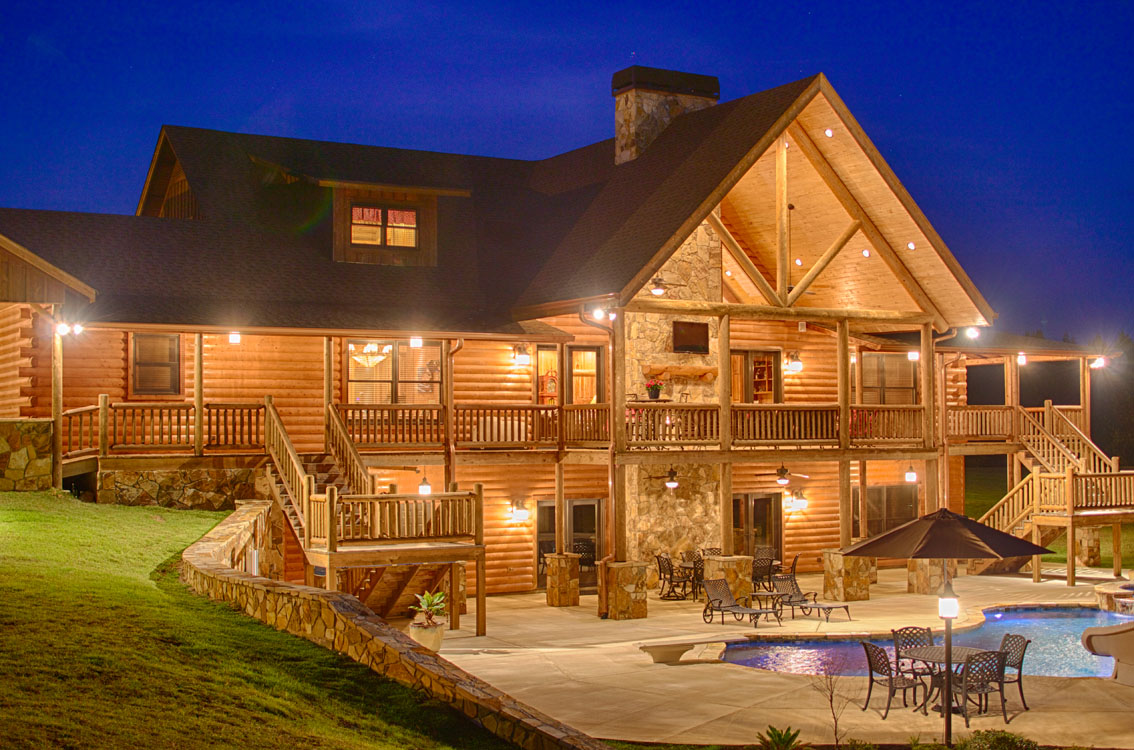 Whether you’re currently building your dream log home or simply checking off tasks on your annual home-maintenance “to do” list, we’re always looking for ways to skimp on expenses around the house. But when it comes to putting your best foot forward with a beautifully stained home that’s also protected from the exterior elements, you might want to think twice before being lured in by the lower price tag of a middle-of-the-road finishing product.
Whether you’re currently building your dream log home or simply checking off tasks on your annual home-maintenance “to do” list, we’re always looking for ways to skimp on expenses around the house. But when it comes to putting your best foot forward with a beautifully stained home that’s also protected from the exterior elements, you might want to think twice before being lured in by the lower price tag of a middle-of-the-road finishing product.
Think about it: Not only does a stain and finish define the aesthetic appeal of your log home, enhancing the striking beauty of the wood’s grain and natural color, but it serves as a shield for your home’s most precious building blocks – the logs. Because of this, it makes sense to spend the extra money upfront on a high-quality finish for your home. And, as it turns out, if you can swing the higher cost for the first application, you will save yourself oodles of cash over the lifetime of your log home.
What are the qualities to look for in a top quality log home finish?
To ensure a successful and long-lasting result, you’ll also need to consider factors like wood protection, maintenance and, of course, appearance.
Appearance: In addition to building a quality home, you want to build a beautiful home, which is why the finished appearance of your logs is so important. By spending a little bit more upfront, you’ll get a distinguished looking wood finish that will set your home apart from the rest.
Are you a DIY-er? Do you like handling home projects, going back and forth to the local hardware store for equipment you need? While Perma-Chink Systems pride ourselves in offering DIY-friendly products, along with a wealth of how-to articles, customer and technical support, some customers choose to hire a contractor.
Or sometimes you can't do it yourself. Time, ability, confidence (or you plain don't want to do it) usually makes the decision for you and you need to find a contractor. Specifically, a log home contractor. 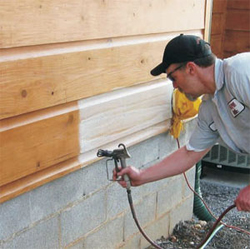
Why a log home contactor? Would you entrust your car to a golf-cart mechanic? While similar in nature, there is a difference between the two. Log home contractors have experience dealing with the unique characteristics that come with a log and timber home. This experience will give you a better result than hiring a painting contractor. Not to mention the long-term relationship the contractors have with the product manufacturer.
Perma-Chink Systems offers an extensive referral list of log home contractors from coast to coast. Most of these contractors are self-employed and none are affiliated with Perma-Chink Systems, but they do have both experience and training in using our products on log and timber homes. Many of the contractors we've worked with for years, and we continually review our referall list to provide our customers with the best available contractors.
Two Steps and Four Questions
Step 1 – Get Smart
A very important first step before interviewing any contractor is to educate yourself. Perma-Chink Systems can help you better understand the steps and nuances of your project. You can attend one of our free homeowner workshops, read through our literature and application guides, or call one of our log home specialists to walk you through the process and related products. Better yet, go online and register for a private webinar with our experts. The more you know about your upcoming project, the better you can ask the right questions and understand the answers from the contractors. So please don’t overlook this important step!
MOBILE LOG CABINS (or PLUG & PLAY TRADITIONAL LOG HOME)
By Dan Waring, British Log Cabins
Mobile homes...Traditionally an ugly metal box, BLC have taken the parameters defining the mobile home and delivered a beautiful alternative LOG CABIN!
Developed in response to an increase in the popularity of ‘Log Cabin Holidays’ our Mobile Log Homes include everything. The entire building is prefabricated off site in our log building yard on a specially designed rolling chassis.
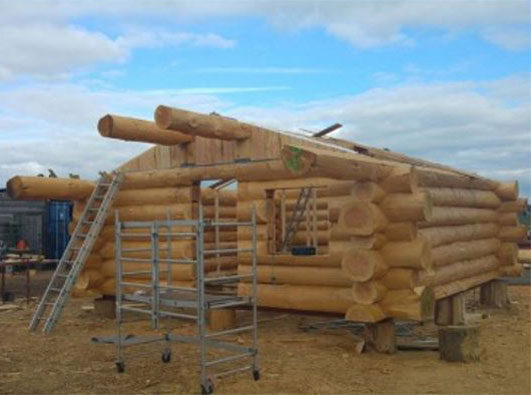 |
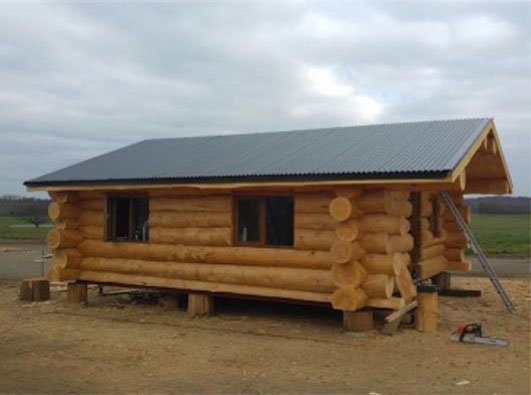 |
The building comes complete including a kitchenette, bathroom suite, LPG boiler, radiators, log burner and all internal finishes.
 |
 |
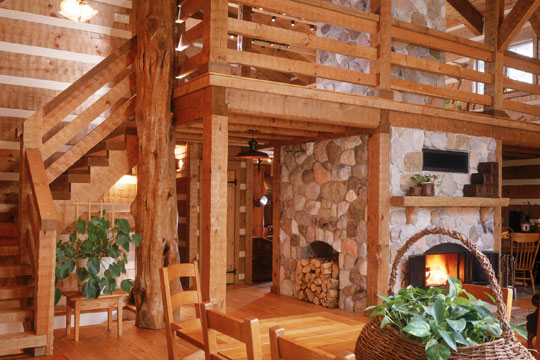 |
All that is required on site is a concrete slab and waste and water connections - they really are a plug and play, traditional log home!.
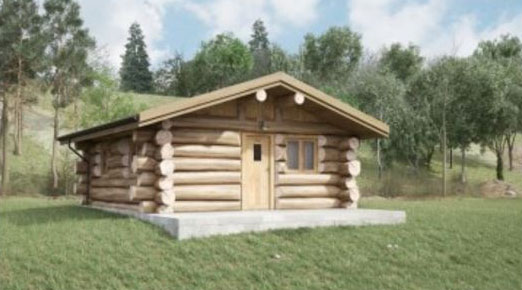 |
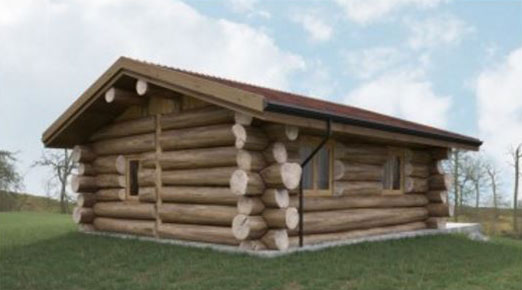 |
Log building as a construction method and art form has been around for centuries. It’s origins were in Eastern Europe and Scandinavia. As a trade it has a long established history. The often romanticized vision of a cozy, traditional log cabin in a holiday area is now a reality.
 After graduating from college, the normal progression for most women is marriage. But, what is great, or even fun, about being normal? This neo-Laura Ingalls-Wilder, this Backwoods Barbie, embarked upon an adventure. I decided to build a log cabin!
After graduating from college, the normal progression for most women is marriage. But, what is great, or even fun, about being normal? This neo-Laura Ingalls-Wilder, this Backwoods Barbie, embarked upon an adventure. I decided to build a log cabin! Since my kit consisted of only the perimeter wall logs, I drew the interior plans one Sunday afternoon; and Mom and I devised a plan that would allow me to “pay-as-I-go” and have the cabin completed and paid-off in three years. However, I did not realize how much I was going to be involved with the “hands-on” construction, and I never imagined how much I would learn to do and end up doing myself.
Since my kit consisted of only the perimeter wall logs, I drew the interior plans one Sunday afternoon; and Mom and I devised a plan that would allow me to “pay-as-I-go” and have the cabin completed and paid-off in three years. However, I did not realize how much I was going to be involved with the “hands-on” construction, and I never imagined how much I would learn to do and end up doing myself.m-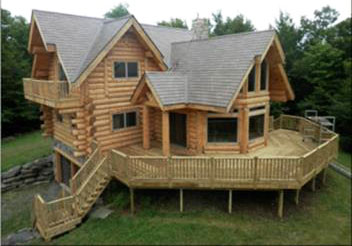
By Lee Denman, Intensified Wood Restoration
There are essentially two types of log home stains available on the market today:
|
Film-Forming Finishes Oil-based (Alkyd) Log Home Stains Latex-based Log Home Stains Acrylic Latex-based Log Home Stains Varnishes for Log Homes |
Penetrating Finishes Oil-based Semi-transparent Log Home Stains
|
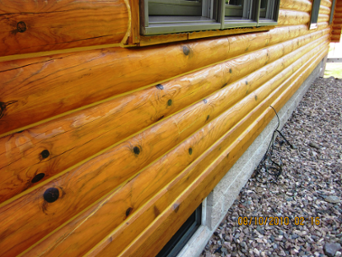 What are the PROS and CONS of each of these types of log home finishes?
What are the PROS and CONS of each of these types of log home finishes?
1. Oil Based (Alkyd) Log Home Stain
PROS: Wood grain visibility, UV Protection, Non Porous, Easy application, longer open times.
CONS: Trap Moisture, Brittle, Can't Breathe, Weather Quickly, Coat build-up over time, Blistering occurs if moisture is present behind finish, High Maintenance.
2. Latex based Solid Color Log Home
PROS: Breathable, Flexible, Durable, High UV Protection, Porous, Easy application, Low maintenance, Long life, low odor.
CONS: Won't prevent decay if conditions are favorable, Short Shelf Life.
3. Semi-Transparent Acrylic Latex based Log Home Stain
PROS: Breathable, Flexible, Durable, High UV Protection, Wood grain visibility, Porous, Low maintenance, Long life, low odor.
CONS: More difficult to apply than oil based stains and solid color stains, fast drying times.
4. Log Home Varnishes
PROS: Allow for natural look of logs.
CONS: High maintenance, prone to Cracking, Peeling and Blistering, Requires recoating every 1-2 years, Partial UV protection.
5. Oil based Semitransparent Log Home Stains
PROS: Penetrate into wood, Wood grain visibility, Breathable, High UV protection.
CONS: Perform best on rough sawn, weathered, or course textured wood. Compatibility issues with most log home sealants due to waxes found in most penetrating finishes. Don't have a furniture grade finish look (dull), must apply second coat before first coat dries in order for stain to penetrate wood. Vapor barrier, non-breathable.
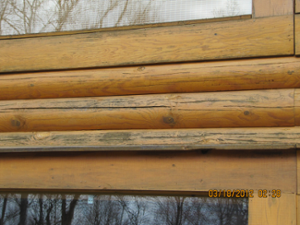 What types of log home stains work the best?
What types of log home stains work the best?
So we have all this helpful information on the types of log home stains but which log home stain is the best? It is hard to say which one is the absolute best because there are many factors that ultimately decide how well or long a log home stain will perform. Some of these factors are:
- What season the logs were cut (winter cut logs only)
- Proper surface preparation
- Environment surrounding building
- Moisture content of logs
Of all these factors none is more important than proper surface preparation of the logs before applying a log home stain. If the surface of the logs has not been prepped properly none of these log home stains will perform as they state they will. This is why it is important to only hire a qualified log home restoration expert to work on your log home! They will have the knowledge and expertise to work with the products available in the current log home market. This will ensure your investment is protected well into the future.
While we can’t say which log home stain is the overall best, we can recommend which type of log home finishes we feel perform exceptionally well and keep maintenance costs down throughout the years. This only holds true if proper surface preparation is kept in mind before and during any finish or sealant application. In our opinion, film-forming, latex based waterborne log home finishes such as Perma-Chink Systems’ Lifeline is best bang for your buck!
While Perma-Chink Systems finishes aren't the cheapest out there they seem to require the least amount of maintenance based on our 25+ years of experience restoring log homes and log cabins of all sizes and shapes. They also offer an unmatched 5 year warranty on their log home stains when applied properly and maintained accordingly.
Lee Denman is the founder of Intensified Wood Restoration Company
Perma-Chink Systems Free Samples
Want to try Perma-Chink Systems products? Order free samples online here.
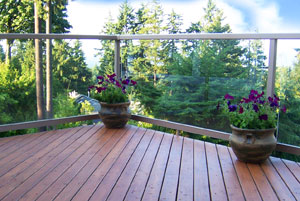 Your decks and railings do not weather in a uniform fashion like your log walls. After a year or two with some deck stains, areas exposed to direct sunlight may hold little or no trace of the original finish, while shaded surfaces may show very little, if any degradation.
Your decks and railings do not weather in a uniform fashion like your log walls. After a year or two with some deck stains, areas exposed to direct sunlight may hold little or no trace of the original finish, while shaded surfaces may show very little, if any degradation.
Maintaining Your Deck
There are three primary elements to your deck which can maximize longevity and structural integrity as well as aesthetics. These include periodic maintenance between applications of stain, preparation of applying new stain and the staining itself.
Regardless of the stain used on your deck, its life can be extended with periodic cleaning. Pooling water can easily be swept off with a push-broom, which can help prevent premature failure of your deck stain. However, cleaning it periodically will make the biggest contribution to maximizing its life and appearance. A diluted solution of Log Wash™ (1 cup per gallon) can easily be applied through a garden pump sprayer ($20 - $30 at any garden center or hardware store) then lightly pressure washed off. If you don’t have access to a pressure washer, a strong jet stream from a garden hose will also work. Remember, here you are trying to clean the deck, not remove the finish.
For decks that may have excessive levels of dirt, mildew, green algae, etc., the mechanical action of scrubbing or using a medium bristle push broom after applying Log Wash will help a lot. Make sure to thoroughly rinse off all detergents as you never want them to dry on the wood surface.
|
|
|
| Photo 1 | Photo 2 |
For decks that have darkened from sun exposure with little or no stain left, a deeper pressure washing can be done to remove the darkened surface in order to get down to clean, bright wood. Photos 1 and 2 above show these results. If necessary, Wood ReNew™ and a pressure washer may be used to clean away any gray UV damaged wood fibers, as well as deep rooted mold and dirt residue.
Your deck is ready to stain immediately after cleaning. Pick your color and apply 1 coat of Deck Defense. Once the initial coat of Deck Defense applied to bare wood, a future maintenance coat applied to a surface previously coated with Deck Defense is easy - clean and recoat, no mechanical or chemical stripping required.
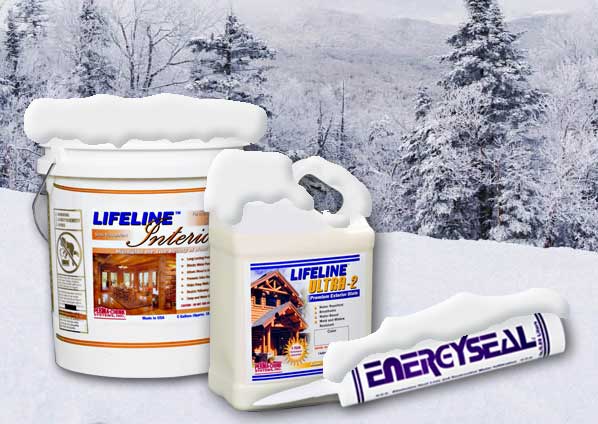 During the winter months it's important to be aware of the freeze-thaw stability of Perma-Chink's products. The reason may involve shipping conditions or whether it is okay to store a product or products in an unheated shed. In any case you need to be aware of the consequences of allowing any of our products to freeze.
During the winter months it's important to be aware of the freeze-thaw stability of Perma-Chink's products. The reason may involve shipping conditions or whether it is okay to store a product or products in an unheated shed. In any case you need to be aware of the consequences of allowing any of our products to freeze.
Without a doubt it is always best to prevent any of our finishes and sealants from freezing. They all contain water and the formation of ice crystals within the products can separate the water from the other components. In some products once this occurs it becomes impossible to regain the properties of the original formulation even after thawing and vigorous mixing. These types of products are not freeze-thaw stable.
With a few exceptions most of our products are freeze-thaw stable, however, if a product becomes frozen it needs to be thawed slowly, preferably at room temperature. Speeding up the thawing process by heating the container can seriously damage the product making it unusable. If the product is in pails or containers, once it has completely thawed it will require a thorough mixing.
If a product is subjected to multiple freeze-thaw cycles each cycle will contribute to the degradation process until it is no longer suitable for use. If a product becomes frozen it is better to allow it to stay frozen than it is to bring it inside to thaw and then store it where it may freeze again. It's the succession of freeze, thaw, freeze, thaw sequences that really destroys the integrity of a product. Before applying any product that's been frozen be sure to test a small amount to see if it is still usable.

To reiterate:
- It's best to protect all of our products from freezing.
- If it does get frozen, thaw it slowly at room temperature then thoroughly mix it.
- It's better to keep it frozen than to subject it to multiple freeze-thaw cycles.
- Before applying any product that's been frozen be sure to test a small amount to see if it is still usable.
Perma-Chink Systems’ products that are NOT freeze-thaw stable:
- Chink Paint™ Textured & Smooth
- Log End Seal™
- Oxcon™
- StripIt
Perma-Chink Systems’ products that have limited freeze-thaw stability (5 cycles):
For information about cold weather storage of Shell-Guard® and Shell-Guard® RTU see "Storing Borate Solutions."
Which Log Home Sealant Should I Use?
We are asked this question very frequently about our two biggest selling log home sealants. Both of these sealants were formulated to weatherproof joinery in log and log sided buildings. Our simplest answer is that in general, Perma-Chink should be used in applications where the seam width is one inch or wider and Energy Seal is a better choice in sealant seams that are narrower than one inch or where joinery was not intended to have chinking applied to it. However, this answer is overly simplistic when you consider the variety of log profiles and joinery types and many different surfaces that come together to make up a finished log structure.
By Tony Huddleston
VP of Sales and Operations, Perma-Chink Systems
Log home living in today’s world can be linked to the same pioneer spirit that helped many of our ancestors forge a new world. The spirit that dwells in so many of us tells us that we want something different from all the rest. Something that enables us to have a different way of expressing our lifestyle that embodies the individuality in some of us that separates us from the masses.
The months or years that are spent researching log home styles, construction methods, visits to dealers and talking with homeowners about their homes are brought to reality when we finally move into a new log home. Hopefully during our quest for the home we wanted that our dealer advised us to plan for maintenance and to design our homes to be “maintenance friendly”. After all we, like our homes are not going to be forever young, so planning for maintenance down the road will pay off big dividends in years to come.
Today’s log homes are not the same homes our ancestors built, as they were often built strictly as a necessity for their families. There were very few thoughts as to anything other than shelter and protection from the elements as well as other predators. Log homes of today are engineered to be structurally sound and take advantage of energy-saving features, much the same as other homes. They are no longer viewed as “cabins”; they are primary homes and second homes or vacation getaways.
Having said that, all of the engineering, planning, and choices you make should also include planning for scheduled maintenance on your home. Maintenance should not be viewed as a chore or just an expense, it should be considered as an investment in your homes’ longevity and value. Properly cared for; log homes will appreciate in value, rather than depreciate. Download the "Inspection Checklist" in PDF here.
If you are new to the lifestyle of log homes, then possibly you may be new to the care and feeding of a log home and may have some questions or reservations as to how this should be done. With a little planning and timely execution it is not as difficult as it may seem.
 Starting with the basics; a walk around your home at least twice a year will help you become acquainted with your home and the condition of the sealants and finishes. If you do see something, get up close and personal to see what is happening. Pay close attention to the South and West sides of your home as that is normally the areas that catch most of the sun, and the ultraviolet rays that come with sunlight will cause those areas to show the quickest signs of needing maintenance. Many folks are under the impression that you always have to re-stain the entire home; when in fact all you may need is a touch up on the weathered side.
Starting with the basics; a walk around your home at least twice a year will help you become acquainted with your home and the condition of the sealants and finishes. If you do see something, get up close and personal to see what is happening. Pay close attention to the South and West sides of your home as that is normally the areas that catch most of the sun, and the ultraviolet rays that come with sunlight will cause those areas to show the quickest signs of needing maintenance. Many folks are under the impression that you always have to re-stain the entire home; when in fact all you may need is a touch up on the weathered side.
During your walk around, pay attention to the sealing system on your home, especially around doors and windows. As checking and fissure development is a naturally occurring process in large timbers, make note of any checks that face upward to catch water and hold moisture that may cause problems. Take special note of any that run behind door and window trim that may allow moisture to work its way to the interior. Also look for any telltale signs that your stain or finish is beginning to need attention; fading, peeling, or dark areas under the finish are good indicators that mean it is time for a maintenance coat.

